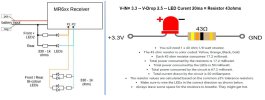collectors
Registered
Hi, Hope you all had a cheap Christmas so you can spend more on your models, lol.
My question is the Micron MR603c P1 P2 receiver outlets a fixed value, or is it dependent on the board input. My input will be around 16v & was wondering on resistor size for the bi-led direction lights.
My question is the Micron MR603c P1 P2 receiver outlets a fixed value, or is it dependent on the board input. My input will be around 16v & was wondering on resistor size for the bi-led direction lights.

